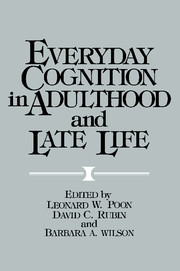Book contents
- Frontmatter
- Contents
- List of contributors
- Preface
- Part I Adult cognitive abilities in the laboratory and in real-life settings: Basic theoretical and methodological issues
- Part IA Systematic approaches to laboratory and real-world research
- Part IB Combining laboratory and real-world research
- Part II Cognition in adulthood and late life: Findings in real-life settings
- 10 Introduction to Part II: What do we know about the aging of cognitive abilities in everyday life?
- Part IIA Everyday cognitive abilities
- Part IIB Concomitant influences
- Part III Cognitive enhancement and aging: Clinical and educational applications
- Part IIIA Issues and perspectives
- Part IIIB Enhancement approaches
- Part IIIC Designing programs for cognitive rehabilitation
- Subject index
- Author index
10 - Introduction to Part II: What do we know about the aging of cognitive abilities in everyday life?
Published online by Cambridge University Press: 05 October 2013
- Frontmatter
- Contents
- List of contributors
- Preface
- Part I Adult cognitive abilities in the laboratory and in real-life settings: Basic theoretical and methodological issues
- Part IA Systematic approaches to laboratory and real-world research
- Part IB Combining laboratory and real-world research
- Part II Cognition in adulthood and late life: Findings in real-life settings
- 10 Introduction to Part II: What do we know about the aging of cognitive abilities in everyday life?
- Part IIA Everyday cognitive abilities
- Part IIB Concomitant influences
- Part III Cognitive enhancement and aging: Clinical and educational applications
- Part IIIA Issues and perspectives
- Part IIIB Enhancement approaches
- Part IIIC Designing programs for cognitive rehabilitation
- Subject index
- Author index
Summary
Neisser's critique (1978) of the functional significance of modern theories of memory played an important part in energizing both laboratory and real-world research. His paper renewed interest in and fueled discussions of the issues of generalizability, predictability, and validity of laboratory methods and findings.
The chapters in Part I of this book have outlined the rationale and arguments underlying the debate concerned with carrying out cognitive research in the laboratory and in the real world. These chapters have clarified the how, when, and why of studying real-world or everyday cognition. This clarification of the conceptual utility of representativeness, generalizations, ecological and external validity, and functional explanations paves the way for reviews of findings on everyday cognition in Part II of this book.
What do we know about cognitive abilities in everyday life along the adult life span? I believe that there is a two-part answer to the question. On the one hand, researchers have gained substantial knowledge about everyday cognition since the 1970s. The 1978 and 1987 conferences on practical aspects of memory (Gruneberg, Morris, & Sykes, 1978) testify to the depth of interest and research. From the perspective of the adult life span, researchers have begun to examine cognitive phenomena with greater precision (Smith, 1980). Although it has not been demonstrated empirically, it has been said that the magnitudes of age differences reported in the research literature over the last three decades have shrunk.
- Type
- Chapter
- Information
- Everyday Cognition in Adulthood and Late Life , pp. 129 - 132Publisher: Cambridge University PressPrint publication year: 1989
- 1
- Cited by



